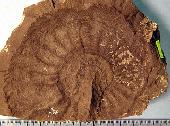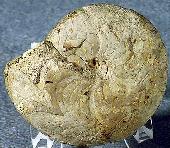|
 See More Images See More Images

Amaltheus stokesi
© 2003 Roland Gangloff, University of Alaska Museum

Muensteroceras parallelum
© 1998 Dr. Richard Paselk, Humboldt State University Natural History Museum

Beloitoceras
© 2003 Milwaukee Public Museum
|
What are Cephalopods? Cephalopods, meaning “head foot,” have a foot that has been modified into flexible arms and a tube (siphon), as well as highly developed eyes and nervous systems. They can move backwards rapidly by expelling water through the siphon. Some members of this group, such as the living Nautilus and the extinct ammonites, have external shells. These shells are divided into chambers, and the cephalopod only lives in the last, largest chamber. Squid, cuttlefish, and extinct forms like belemnites, have internal shells, many of which are also chambered. Octopuses have no shells. Members of this group first appear in the Devonian, and some members are still around today. First known fossil occurrence: Cambrian. Last known fossil occurrence: Quaternary. This group has living relatives. |
Fossils through time:
Choose a time period to see what life was like:
|
|